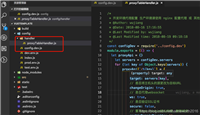基本概念与作用说明
vue.js 是一个用于构建用户界面的渐进式框架,它通过声明式的数据绑定和组件化的架构,使得开发者可以轻松地创建复杂的单页应用。在vue中,数据的双向绑定机制使得数据联动变得非常简单和直观。
数据联动的作用
数据联动是指一个列表的变化会触发另一个列表的变化。这种机制可以用于以下场景:
- 过滤筛选:用户在第一个列表中选择某个选项后,第二个列表会根据选择的结果进行过滤。
- 关联选择:用户在第一个列表中选择某个选项后,第二个列表会显示与之相关的数据。
- 级联选择:用户在第一个列表中选择某个选项后,第二个列表会显示下一级的数据,例如省市区选择。
示例一:基本的两列表联动
首先,我们来实现一个基本的两列表联动功能,其中一个列表的变化会触发另一个列表的变化。
<template>
<div>
<h3>选择类别</h3>
<select v-model="selectedcategory">
<option v-for="category in categories" :key="category.id" :value="category.id">
{{ category.name }}
</option>
</select>
<h3>选择产品</h3>
<select v-model="selectedproduct">
<option v-for="product in filteredproducts" :key="product.id" :value="product.id">
{{ product.name }}
</option>
</select>
</div>
</template>
<script>
export default {
data() {
return {
categories: [
{ id: 1, name: '电子产品' },
{ id: 2, name: '家居用品' },
{ id: 3, name: '书籍' }
],
products: [
{ id: 1, name: '手机', categoryid: 1 },
{ id: 2, name: '电视', categoryid: 1 },
{ id: 3, name: '沙发', categoryid: 2 },
{ id: 4, name: '书架', categoryid: 2 },
{ id: 5, name: '小说', categoryid: 3 },
{ id: 6, name: '编程书', categoryid: 3 }
],
selectedcategory: null,
selectedproduct: null
};
},
computed: {
filteredproducts() {
if (!this.selectedcategory) {
return this.products;
}
return this.products.filter(product => product.categoryid === this.selectedcategory);
}
}
};
</script>
在这个示例中,我们有两个下拉列表,一个是类别选择,另一个是产品选择。当用户选择一个类别后,产品列表会根据选择的类别进行过滤。
示例二:使用事件传递实现联动
在某些情况下,我们可能需要在父组件和子组件之间传递数据。这时可以使用vue的事件系统来实现联动。
父组件
<template>
<div>
<h3>选择类别</h3>
<select v-model="selectedcategory">
<option v-for="category in categories" :key="category.id" :value="category.id">
{{ category.name }}
</option>
</select>
<h3>选择产品</h3>
<product-list :categoryid="selectedcategory" @product-selected="onproductselected"></product-list>
</div>
</template>
<script>
import productlist from './productlist.vue';
export default {
components: {
productlist
},
data() {
return {
categories: [
{ id: 1, name: '电子产品' },
{ id: 2, name: '家居用品' },
{ id: 3, name: '书籍' }
],
selectedcategory: null,
selectedproduct: null
};
},
methods: {
onproductselected(productid) {
this.selectedproduct = productid;
}
}
};
</script>
子组件
<template>
<select @change="onproductchange">
<option v-for="product in filteredproducts" :key="product.id" :value="product.id">
{{ product.name }}
</option>
</select>
</template>
<script>
export default {
props: {
categoryid: number
},
data() {
return {
products: [
{ id: 1, name: '手机', categoryid: 1 },
{ id: 2, name: '电视', categoryid: 1 },
{ id: 3, name: '沙发', categoryid: 2 },
{ id: 4, name: '书架', categoryid: 2 },
{ id: 5, name: '小说', categoryid: 3 },
{ id: 6, name: '编程书', categoryid: 3 }
]
};
},
computed: {
filteredproducts() {
if (!this.categoryid) {
return this.products;
}
return this.products.filter(product => product.categoryid === this.categoryid);
}
},
methods: {
onproductchange(event) {
this.$emit('product-selected', event.target.value);
}
}
};
</script>
在这个示例中,父组件通过categoryid属性将类别id传递给子组件,子组件根据类别id过滤产品列表,并在用户选择产品时通过自定义事件product-selected将选择的产品id传递回父组件。
示例三:使用vuex管理全局状态
对于大型应用,可能需要在多个组件之间共享数据。这时可以使用vuex来集中管理状态。
store/index.js
import vue from 'vue';
import vuex from 'vuex';
vue.use(vuex);
export default new vuex.store({
state: {
categories: [
{ id: 1, name: '电子产品' },
{ id: 2, name: '家居用品' },
{ id: 3, name: '书籍' }
],
products: [
{ id: 1, name: '手机', categoryid: 1 },
{ id: 2, name: '电视', categoryid: 1 },
{ id: 3, name: '沙发', categoryid: 2 },
{ id: 4, name: '书架', categoryid: 2 },
{ id: 5, name: '小说', categoryid: 3 },
{ id: 6, name: '编程书', categoryid: 3 }
],
selectedcategory: null,
selectedproduct: null
},
mutations: {
setselectedcategory(state, categoryid) {
state.selectedcategory = categoryid;
},
setselectedproduct(state, productid) {
state.selectedproduct = productid;
}
},
actions: {
selectcategory({ commit }, categoryid) {
commit('setselectedcategory', categoryid);
},
selectproduct({ commit }, productid) {
commit('setselectedproduct', productid);
}
},
getters: {
filteredproducts(state) {
if (!state.selectedcategory) {
return state.products;
}
return state.products.filter(product => product.categoryid === state.selectedcategory);
}
}
});
组件
<template>
<div>
<h3>选择类别</h3>
<select @change="oncategorychange">
<option v-for="category in categories" :key="category.id" :value="category.id">
{{ category.name }}
</option>
</select>
<h3>选择产品</h3>
<select @change="onproductchange">
<option v-for="product in filteredproducts" :key="product.id" :value="product.id">
{{ product.name }}
</option>
</select>
</div>
</template>
<script>
import { mapstate, mapgetters, mapactions } from 'vuex';
export default {
computed: {
...mapstate(['categories', 'selectedcategory', 'selectedproduct']),
...mapgetters(['filteredproducts'])
},
methods: {
...mapactions(['selectcategory', 'selectproduct']),
oncategorychange(event) {
this.selectcategory(event.target.value);
},
onproductchange(event) {
this.selectproduct(event.target.value);
}
}
};
</script>
在这个示例中,我们使用vuex来管理类别和产品的状态,并通过计算属性和映射方法来访问和修改状态。
示例四:动态生成列表项
有时候,列表项的数据需要从服务器动态获取。我们可以使用vue的异步数据获取功能来实现这一点。
<template>
<div>
<h3>选择类别</h3>
<select @change="oncategorychange">
<option v-for="category in categories" :key="category.id" :value="category.id">
{{ category.name }}
</option>
</select>
<h3>选择产品</h3>
<select v-if="products.length > 0" @change="onproductchange">
<option v-for="product in products" :key="product.id" :value="product.id">
{{ product.name }}
</option>
</select>
<div v-else>加载中...</div>
</div>
</template>
<script>
import axios from 'axios';
export default {
data() {
return {
categories: [
{ id: 1, name: '电子产品' },
{ id: 2, name: '家居用品' },
{ id: 3, name: '书籍' }
],
products: [],
selectedcategory: null,
selectedproduct: null
};
},
methods: {
async fetchproducts(categoryid) {
try {
const response = await axios.get(`/api/products?categoryid=${categoryid}`);
this.products = response.data;
} catch (error) {
console.error('获取产品失败:', error);
}
},
oncategorychange(event) {
this.selectedcategory = event.target.value;
this.fetchproducts(this.selectedcategory);
},
onproductchange(event) {
this.selectedproduct = event.target.value;
}
}
};
</script>
在这个示例中,当用户选择一个类别后,我们会通过axios从服务器获取对应类别的产品数据,并更新产品列表。
示例五:使用插槽实现灵活的列表展示
在某些场景下,我们可能需要在列表项中展示更多的信息,例如图片、描述等。这时可以使用vue的插槽功能来实现灵活的列表展示。
父组件
<template>
<div>
<h3>选择类别</h3>
<select v-model="selectedcategory">
<option v-for="category in categories" :key="category.id" :value="category.id">
{{ category.name }}
</option>
</select>
<h3>选择产品</h3>
<product-list :categoryid="selectedcategory">
<template v-slot:item="{ product }">
<div>
<img :src="product.image" alt="产品图片" />
<p>{{ product.name }}</p>
<p>{{ product.description }}</p>
</div>
</template>
</product-list>
</div>
</template>
<script>
import productlist from './productlist.vue';
export default {
components: {
productlist
},
data() {
return {
categories: [
{ id: 1, name: '电子产品' },
{ id: 2, name: '家居用品' },
{ id: 3, name: '书籍' }
],
selectedcategory: null
};
}
};
</script>
子组件
<template>
<div>
<slot v-for="product in filteredproducts" :product="product" name="item"></slot>
</div>
</template>
<script>
export default {
props: {
categoryid: number
},
data() {
return {
products: [
{ id: 1, name: '手机', categoryid: 1, image: 'phone.jpg', description: '高性能智能手机' },
{ id: 2, name: '电视', categoryid: 1, image: 'tv.jpg', description: '高清智能电视' },
{ id: 3, name: '沙发', categoryid: 2, image: 'sofa.jpg', description: '舒适家用沙发' },
{ id: 4, name: '书架', categoryid: 2, image: 'bookshelf.jpg', description: '多功能书架' },
{ id: 5, name: '小说', categoryid: 3, image: 'novel.jpg', description: '经典文学作品' },
{ id: 6, name: '编程书', categoryid: 3, image: 'programming.jpg', description: '编程入门指南' }
]
};
},
computed: {
filteredproducts() {
if (!this.categoryid) {
return this.products;
}
return this.products.filter(product => product.categoryid === this.categoryid);
}
}
};
</script>
在这个示例中,父组件通过插槽传递了一个模板,用于在子组件中展示每个产品的详细信息。
实际工作中的使用技巧
在实际开发过程中,处理列表数据联动可能会遇到各种挑战。以下是一些有用的技巧:
- 性能优化:对于大数据量的列表,可以使用虚拟滚动技术来优化性能。
- 错误处理:在网络请求中添加错误处理逻辑,确保用户在遇到网络问题时能够得到友好的反馈。
- 用户体验:提供加载指示器和错误提示,提升用户体验。
- 代码复用:将常用的列表组件封装成可复用的组件,减少重复代码。
- 测试:编写单元测试和端到端测试,确保功能的正确性和稳定性。
总之,通过上述示例和技巧,我们可以看到vue框架在处理列表数据联动方面的强大能力和灵活性。希望本文能为你的vue项目开发带来启发和帮助。
到此这篇关于vue实现两个列表之间的数据联动的代码示例的文章就介绍到这了,更多相关vue两表数据联动内容请搜索代码网以前的文章或继续浏览下面的相关文章希望大家以后多多支持代码网!







发表评论